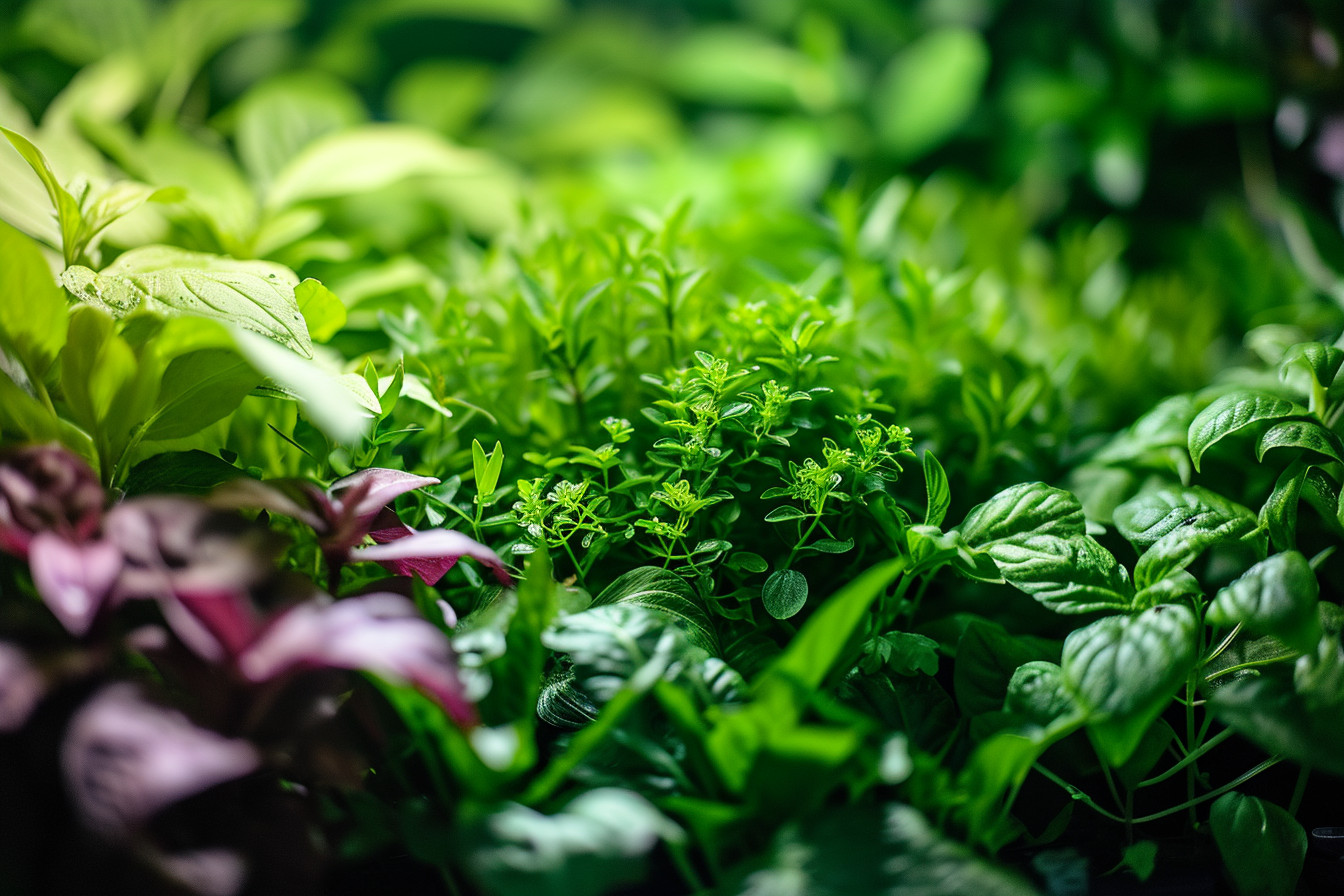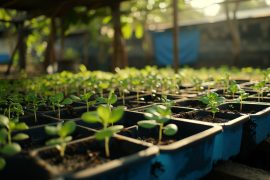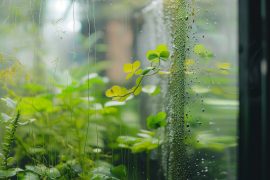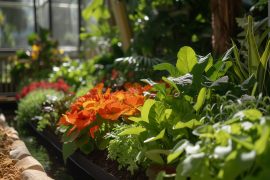Starting my first aquaponic system felt like stepping into a serene, underwater garden. There’s something incredibly peaceful about watching plants thrive in harmony with fish, all while I’m sipping my morning coffee. It’s a little ecosystem that’s not just calming to the soul but also a feast for the eyes.
But let’s get real—knowing which plants to pick can be overwhelming. That’s why I’m about to break down my top 10 favorites that are perfect for beginners. These plants are not only resilient but also make your aquaponic journey educational and, dare I say, pretty fun. So, if you’re looking to dip your toes into the tranquil waters of aquaponics, you’re in the right place.
Benefits of Aquaponic Systems
As I delve deeper into the world of aquaponics, I’ve found a myriad of benefits that go beyond just the aesthetic pleasure of having a garden. It’s literally a symbiotic environment where fish and plants grow together, with each supporting the life of the other. It’s not just a garden; it’s a harmonious eco-system in miniature.
Creating a Peaceful Sanctuary
One of the aspects I love most about my aquaponic system is the peaceful sanctuary it creates. There’s a tranquil calmness that comes from watching the fish gently swim while the plants gently sway above them. This tranquility is a reminder of the delicate balance in nature, and it’s amazing to think that I have a piece of that right in my own home.
A Hands-On Learning Experience
My journey into aquaponics has been incredibly educational, and I believe it can be for you too. It’s one thing to read about the nitrogen cycle or plant nutrition, but it’s another to see it in action. You get to witness the natural filtration as the fish waste provides nutrients for the plants, and then the plants, in turn, clean the water for the fish.
High Yields in Small Spaces
For those who are space-conscious, aquaponic systems are game-changers. You can achieve remarkably high yields with a relatively small footprint. Since the systems are typically stackable, you can also take advantage of vertical space, which is a game-changer in urban settings or small backyards.
Sustainable and Eco-Friendly
Aquaponics is a prime example of sustainable gardening. It requires significantly less water than traditional soil-based gardening because the water is recirculated. It’s a low-waste system as well, so it’s kind to the planet.
Health Benefits
Gardening, in general, is good for your health, and aquaponics is no exception. There’s something inherently satisfying about growing your own food. It’s nourishing not just for your body, but for your soul. Plus, it’s a wonderful way to reduce your carbon footprint, which is good for your peace of mind.
Choosing the Right Plants for Your Aquaponic System
When I first started with aquaponics, I was amazed by the tranquility it brought into my life. The sound of water gently flowing and plants thriving in this symbiotic environment offered a serene retreat from the bustle of everyday life. Gardening, especially in such a unique system, connects me with nature and quiets my mind, so I know firsthand how important it is to choose the right plants to maintain that harmony.
The plants you select for your aquaponic system are more than just ornaments; they’re crucial components of an ecological puzzle. They’re what make your garden not just alive, but thrive. Let me guide you through some aspects to consider when picking the perfect green companions for your watery oasis.
Lighting and Space Requirements
Check the lighting requirements of the plants you’re eyeing. Some love the sunshine and need loads of it, while others might prefer the cooler, shadier spots. And let’s talk space – not all plants are the same size at maturity, so plan ahead for how much room they’ll need to spread their leaves.
Fish Compatibility
Remember, your plants are sharing space with fish, so you want to ensure they’re good roommates. Some plants might alter the water chemistry unfavorably for your fish, so always double-check the compatibility.
Growth Habits
Consider how your plants grow. Some, like mint, can be aggressive and take over if not kept in check. You want a balanced ecosystem, where your plants coexist without one overshadowing the others.
Nutrient Requirements
Different plants require different nutrients in various quantities. Leafy greens might flourish with the nutrients your fish provide, but fruiting plants might need additional supplements. It’s a delicate balance, and understanding nutrient uptake can take your aquaponic system from struggling to stunning.
Edible vs. Ornamental
Are you looking to garnish your dishes with fresh herbs straight from the system or just marvel at the beauty of flowering plants? That’s a decision you’ll need to make, as it’ll influence the type of plants you grow.
Local Climate and Season
Your local climate plays a significant role in what plants will thrive in an outdoor aquaponic system. If you’re working indoors, you have more control, but remember to mimic the plant’s natural conditions as closely as possible.
Top 10 Plants for Your First Aquaponic System
When I’m knee-deep in the tranquility of my aquaponic garden, there’s nothing quite like watching the delicate dance of fish beneath the water’s surface while lush plants thrive above. If you’re looking to start your aquaponic journey, selecting the right plants is crucial. Not just for your peace of mind but for the harmony of your entire system.
Let’s delve into the top ten plants that’ll make your aquaponic garden a serene oasis and a thriving hub of natural goodness. It’s like curating a playlist for the perfect garden vibe, where every plant plays a crucial note.
- Lettuce – This one’s an aquaponic chart-topper. It’s easy to grow and doesn’t demand a lot. Plus, there’s nothing quite as gratifying as harvesting your own salad greens.
- Kale – The sturdy kale plant is a champion in the garden, standing strong and leafy, packed with nutrients, and a friend to the cooler climates.
- Basil – The aroma alone is a garden’s melody, and it’s as versatile in the kitchen as it is in the water. Basil and fish? They’re practically BFFs.
- Watercress – It springs to life in water-based systems, delivering a peppery zing to any dish—it’s like a flavor concert for your taste buds.
- Tomatoes – While they’re a bit more advanced, the payoff in plump, juicy bursts of flavor is worth the extra effort. And when the vines flourish, they’re a sight to behold.
- Cucumbers – They’re like the cool, crisp addition every garden party needs. Spanning their vines, they’re a testament to the lushness an aquaponic system can achieve.
- Bell Peppers – These vibrant, colorful characters bring a certain pizzazz to your system. Keep their space needs in mind, and they’ll be showstoppers.
- Mint – Oh, the mint plant! It’s a refreshing, spreading green that’s eager to grow with just a hint of containment to keep its enthusiasm in check.
- Swiss Chard – With leaves that blush with color and a taste that’s tender and earthy, Swiss chard is a delight in the garden and on the plate
1. Leafy Greens
I’ve always found that leafy greens are like the welcoming committee of any aquaponic system. They grow effortlessly, casting a soft green hue to the setup that’s got a way of putting you at ease. When the rush of the water mingles with the sight of tender leaves, it’s like a melody of peace and growth – creating a space of unmatched tranquility.
Lettuce, for example, is almost a no-brainer. I’ve seen so many first-time aquaponic enthusiasts beam with pride at their lush, leafy crop. It’s not just that it’s easy to grow; it’s the fact that you can quite literally watch it burgeon day by day which adds to that calm satisfaction. Then there’s kale – the hardy superstar that can withstand cooler temperatures, keeping your aquaponic garden green even when it’s sweater weather outside.
And let’s not forget about mizuna and arugula, with their distinct flavors bringing a zesty spark to your salads. Even with minimal gardening skills, you can harvest these tangy greens, making your introduction to aquaponics not just educational but thoroughly appetizing.
During one of my aquaponic workshops, I shared a simple tip that turned beginners into confident growers: start with leafy greens that require less light and have shorter growth cycles. People were amazed how this simple advice made them feel like veteran gardeners within weeks.
Case in point, an urban teacher started an aquaponic system in her classroom with butterhead lettuce. Her students, armed with a newfound connection to nature, were growing and tasting their own produce. By the semester’s end, they weren’t just kids in a science class; they were young aquaponic farmers witnessing the entire growth cycle from sprouts to salads.
Breaking down the process, managing a healthy leafy green section requires understanding some basics:
- pH levels should stay between 5.5 and 6.5 for optimal growth
- Nutrient-rich water from the fish tank feeds the plants, reducing the need for additional fertilizers
- Cool-white LED lights or fluorescents can provide the necessary illumination for photosynthesis without excessive heat
2. Herbs
When I’m knee-deep in my serene garden space, there’s nothing quite like the delicate whispers of herbs like basil and mint as they sway in the gentle breeze. It takes me to a peaceful place where the only thing that matters is the here and now. Herbs have this almost magical way of connecting us with the moment, don’t they? Filling the air with their aromatic presence, herbs are not just culinary treasures; they’re also perfect for aquaponic systems.
I’ve found through my journey that introducing herbs into your aquaponics setup is a savvy move. Not only do they grow faster with the rich nutrients from fish, but they also add a splash of green that’s as good for your soul as it is for your plate. And here’s the kicker — herbs are surprisingly undemanding. You get all the flavor and fragrance without the usual gardening fuss.
Let’s dive into some of my favorites:
- Basil: This is a no-brainer. I mean, who doesn’t love the smell of fresh basil? Plus, basil and aquaponics go together like peas and carrots. It thrives in this environment, and before you know it, you’ll have more basil than you know what to do with.
- Mint: Talk about a hardy plant. Mint grows like a weed—fortunately, the kind we want. Keep this one in its own space though; it likes to spread its legs and take over the place.
- Parsley: It’s more than a garnish, folks. Parsley grows lush and full in an aquaponic system, adding that fresh, clean taste to your dishes.
- Cilantro: Love it or hate it — cilantro can be a punchy addition to your aquaponic setup. Don’t worry about that bolt-to-seed habit; in aquaponics, it’s much more manageable.
- Chives: These little green shoots of joy are as resilient as they come. Chives don’t ask for much and in return, they give you bursts of onion flavor for your cooking.
3. Tomatoes
When I think about the luscious fruits of gardening, tomatoes certainly come to mind. Imagine stepping into your tranquil aquaponic oasis where the vibrant reds of ripening tomatoes offer a striking contrast against the verdant foliage. It’s a simple scene that provides a profound sense of peace and connection to the cycle of life.
Tomatoes aren’t just aesthetically pleasing; they’re a cornerstone of horticultural success stories. With their versatile use in the kitchen, growing tomatoes aquaponically lets you witness the entire journey from seedling to your salad bowl. However, they can be a bit more challenging than leafy greens, but I firmly believe they’re worth the effort.
Here’s what I’ve learned: tomatoes are heavy feeders, requiring ample nutrients to flourish, which aquaponics can provide efficiently. In my experience, it’s crucial to choose the right variety for your system. Dwarf and bush types adapt better to the spatial constraints and benefit from the support structure your system may provide.
Optimal Conditions for Tomatoes in Aquaponics
Creating the perfect environment for tomatoes means you need to be a tad more attentive. They thrive in warmer climates and regular pruning becomes essential to manage their growth. It’s a joy, though, to engage with your plants, snipping away unnecessary leaves to make sure every tomato receives its share of sun and air; it’s a perfect time for reflection too.
- Temperature: Keep a consistent range between 59°F and 95°F
- pH Levels: Aim for a sweet spot between 5.5 and 6.5
- Pruning: Regularly to encourage fruiting
Tomato Varieties Best Suited for Aquaponics
I’ve had success with the ‘Cherry’ and ‘Roma’ varieties—they’re robust, forgiving, and serve as a rewarding choice for beginners. If you’re feeling adventurous, you could try heirloom varieties such as ‘Brandywine’ or ‘San Marzano’. They can bring a touch of history to your garden and a burst of heirloom flavor to your dishes.
| Variety | Growth Cycle | Fruit Size | Flavor Notes |
|---|---|---|---|
| Cherry | Fast | Small | Sweet, versatile |
4. Peppers
I’ve always been mesmerized by the serene feeling I get when I’m surrounded by my garden. The vibrant colors and varying textures bring a sense of peace, and among those nurturing spaces, growing peppers in an aquaponic system is a practice that beautifully combines tranquility with a tangible reward.
Back in the day, I remember reading about the ancient forms of aquaponics used by the Aztecs and how they cultivated plants on floating islands, called chinampas. Imagining those ingenious methods gives me an appreciation for how far we’ve come. Nowadays, peppering our modern aquaponic systems brings to us both history and nutrition, right on our doorsteps.
To educate those who are new to this, let’s demystify a term often thrown around in the aquaponic world: “heavy feeders.” Peppers, much like tomatoes, are known as heavy feeders. This simply means they thrive when they’re given a bounty of nutrients, which your fish-yielding water can amply supply. I’ve noticed that the more I care for the balance of my system, the more flavorful and robust my peppers become.
Choosing the right variety of pepper for your system is crucial. I’ve had great success with bell peppers and jalapenos. They don’t just add a pop of color against the green leaves but also serve as a versatile ingredient in my culinary adventures. Here are a few things to remember for optimal pepper growth:
- Temperature: Peppers enjoy warmth. Aim for a range of 70-85°F (21-29°C).
- pH level: Keep it between 5.5 and 6.5 for the best results.
- Light: Ensure they receive plenty of sunlight or artificial light — about 14-18 hours a day.
From my experience, allowing enough space for each plant aids in the healthy development of peppers. Crowding them can limit their access to nutrients and light, so I’m always careful to space them out.
5. Cucumbers
When I first dipped my toes into the world of aquaponics, cucumbers weren’t the first plant to pop into my mind. But as I’ve learned, and as you’re about to find out, these vine-growing wonders are a perfect fit for this harmonious garden setup.
Cucumbers, like the tranquility in a garden, bring a fresh and soothing energy to an aquaponic system. They’re the type of crop that just keeps giving, growing rapidly and prolifically, reminding me of the ever-evolving journey that gardening is. I love the way the vines reach out, grasping onto whatever support they can find, much like how we look to nature for a hand to steady us in times of unrest.
For those of you who are likewise entranced by the promise of homegrown veggies, cucumbers are a fantastic educational tool. These plants teach us about the delicate balance necessary in aquaponic systems with their need for specific conditions. They thrive in warm environments, with temperatures hovering between 70 and 80 degrees Fahrenheit. The pH levels too are vital, and cucumbers have shown me they prefer it slightly alkaline, around 5.5 to 6.7.
Speaking of balance, let’s talk about nutrients. Cucumbers are somewhat heavy feeders, but not overly so. They require a decent amount of nitrogen, potassium, and phosphorus to fruit properly. This need for nutrients makes them a great indicator plant; if your cukes aren’t happy, it might be a sign to check the balance of your system.
Here’s a quick rundown on optimizing conditions for cucumbers:
- Temperature: 70-80°F (21-27°C)
- pH level: 5.5-6.7
- Spacing: 18 inches apart
Sure, there’s a bit of technical language thrown around in aquaponics. Terms like ‘nitrogen cycle,’ ‘nitrifying bacteria,’ or ‘biofilter’ might seem intimidating, but they’re really just pieces of a puzzle that, once understood, make the whole picture clear. And cucumbers? They fit right into that puzzle.
6. Beans
Every time I wander through my aquaponic garden, I can’t help but marvel at the greenery that cascades like waterfalls, and among those gentle waves of leaves, beans stand out as both a practical and peaceful addition to any setup. They’re not just plants; they’re like quiet companions that offer a sense of connection to the earth—even when they’re growing in water.
Growing beans in an aquaponic system is a journey that combines simplicity and productivity. They require very little from us, but in return, they offer so much. You know, beans are more than just plants; they’ve been part of human agriculture for thousands of years. They carry a history of nourishment and have been a staple in diets across the globe. But let’s dig into this amazing plant and see how it thrives in the aquatic home we create for it.
First off, it’s key to understand the type of bean that suits an aquaponic system. I tend to go for dwarf or bush beans—they don’t need much space and are easier to manage in contained environments. They grow eagerly, reaching out to the sun, and before you know it, you’ll see those tiny green pods hanging delicately from their stalks.
For the beans to flourish, I’ve learned that maintaining a pH level between 6.0 and 6.5 is crucial. It’s like setting the right mood for a peaceful evening at home; get this balance right, and the beans seem to grow happier by the day. The temperature is another factor; beans prefer it to be between 70°F and 80°F—a warm cozy blanket in the world of aquaponics.
The setup isn’t just for growing; it becomes an ongoing lesson in balance and care. Beans are an excellent choice for educational purposes, too. I’ve watched kids’ eyes light up as they see the nitrogen cycle in action—beans have this cool trick up their sleeves, they work with bacteria that help fix nitrogen from the air. So while they’re a good fit for aquaponics, they’re also teaching us about symbiotic relationships in nature.
7. Strawberries
As a passionate gardener, I find that there’s something almost meditative about tending to strawberries in an aquaponic system. They’re not just plants; they’re like a quiet nod to the wonders of nature. Strawberries bring a harmonious splash of color and sweetness to the garden space, and they’ve got this unique ability to connect us to the earth—even when they’re growing in water.
When I first ventured into aquaponics, strawberries were one of the plants I was eager to include. They’re known for their high yields and remarkable adaptability to different growing environments, which makes them an excellent choice for someone just dipping their toes into the water. In the tranquility of my garden, watching the strawberries thrive in their aquatic home feels almost like a silent symphony of growth.
Let’s talk about how to get started. I’ll break down some of the basics for growing strawberries in an aquaponic system so you can experience this tranquil connection too:
- pH Levels: Strawberries prefer a slightly acidic environment, with pH levels ranging between 5.5 and 6.5.
- Temperature: They’re a bit temperature-sensitive. Aim for a range between 65 and 80 degrees Fahrenheit during the day and a little cooler at night.
- Nutrient Requirements: Strawberries do love their nutrients, particularly potassium and calcium.
Understanding the technical side is essential but trust me, it’s not as daunting as it might sound. Even terms like “nutrient film technique” simply refer to a method where a thin film of water is allowed to flow over the roots of the plants providing them with all the necessary nutrients and oxygen.
And here’s a bit of a story for you; I remember when I first planted strawberry crowns in my system. I was worried they’d struggle to adapt, but it was as if they burst to life overnight. The blossoms turned into fruits much faster than I anticipated, and it wasn’t long before I was plucking ripe, red strawberries straight from the plant. Each berry felt like a little trophy, a sweet reward for patience and perseverance.
8. Radishes
When I think about peaceful gardening, my mind drifts to radishes. There’s something special about these root veggies; they’re like the quiet achievers of the aquaponic world. Every time I tuck radish seeds into the grow beds of my system, I find myself entering a meditative state, feeling deeply connected to the cycles of growth and nature.
For those new to this, radishes are the perfect addition to a beginner’s aquaponic system. They’re not only easy to grow but also incredibly fast-maturing – you can expect to harvest them in as little as three to four weeks. That’s right, blink and they’re ready to add a crunchy, peppery kick to your salad.
Understanding the essentials for growing radishes in an aquaponic setup isn’t tough. They prefer a pH range of 6.0-7.0 and thrive in cooler water temperatures – making them ideal for systems located in less tropical environments. Plus, their minimal space requirements make them space-efficient.
Speaking of specifics, I remember the first time I saw my aquaponic radishes poking their red shoulders out of the grow media. It felt like a victory – a tangible reward for the care and attention I’d invested. With radishes, there’s a sense of immediacy in the feedback between your efforts and their growth. Witnessing their rapid development from seed to edible root has a way of grounding you, reminding you of nature’s simple yet profound rhythms.
As far as nutrients, radishes aren’t demanding. A well-balanced aquaponic system will naturally provide ammonia-nitrifying bacteria, transforming fish waste into nitrate-rich water – the perfect cocktail for radish growth. It’s a win-win; your fish are happy, and your radishes are bustling with vitality.
Let me share a quick tip: monitor your radishes for signs of potential nutrient deficiencies, especially if you’re simultaneously growing leafy greens that can be heavy feeders. It’s a simple but effective way to ensure all your plants stay as delighted as your tastebuds will be when you finally get to savor these fiery little gems.
9. Swiss Chard
When I think about calmness in my aquaponic garden, Swiss Chard stands out like a green beacon of tranquility. There’s something genuinely therapeutic about watching those broad, vivid leaves unfold. Chard’s sturdy stalks, painted in a spectrum of colors, from ruby red to sunny yellow, make it an aesthetic delight in any system.
Getting into the technical side of growing chard is a cinch. Swiss Chard is as hardy as they come, thriving in a broad range of temperatures, though it prefers the cooler side of the spectrum. You’ll wanna keep your water between 68°F and 75°F (20°C-24°C), which essentially sets the perfect scene for these leafy greens. As for pH levels, Swiss Chard isn’t too fussy, but it does best in a range between 6.0 and 7.0.
Chard loves a balanced diet. Make sure your fish are well-fed and producing enough nutrients, and these greens will gobble them up, transforming them into those nutrient-packed leaves you’re after. Now, if you’re just starting, I’ve got a little tip from my days of trial and error: Swiss Chard can be a bit of a slow starter, so don’t fret if it seems it’s taking its sweet time – patience is key here.
The satisfaction of growing Swiss Chard in an aquaponic system goes beyond the plate. I can’t tell ya how gratifying it is to pull up a chair next to my system, hands wrapped around a warm cup of coffee, just taking in the serenity that these plants provide. It’s like their steady growth and resilience have a way of reminding me to take things one day at a time.
Let’s get down to some practical advice. When you’re planting Swiss Chard, make sure you give each plant about 6 to 12 inches of space to spread out. Crowding isn’t their cup of tea, and if you’re tight on space, you’re better off sticking to a few plants to ensure they flourish. Also, keep an eye out for any discoloration or spots on their leaves – it’s the plants’ way of telling you they might need a nutrient boost or a change in conditions.
10. Kale
I’ve always found there’s something profoundly peaceful about nurturing a plant from seed to harvest, and when it comes to aquaponic systems, kale is among the stars that shine especially bright. It’s not just a powerhouse nutrient-wise for us, but also a joy to grow in the enclosed symbiosis of fish and plants.
Kale, or as the scientists call it, Brassica oleracea, is a hardy leafy green that’s come a long way from its origins in the eastern Mediterranean and Asia Minor. Who would’ve thought our ancestors tending wild kale would lead to us growing it in water with fish? There’s a remarkable history trailing behind those curly leaves, and it’s enchanting to be part of that journey.
From a technical standpoint, kale’s pretty robust. It thrives in slightly cooler temperatures ranging from 65 to 75 degrees Fahrenheit (18-24°C). You’ll want to maintain your pH between 5.5 and 6.5 to see that vibrant green flourish. I’ve seen some beginners get a little nervous about the specifics, but honestly, once you get the hang of it, you’re golden.
Planting Kale in Aquaponics: Getting It Right
- Start with high-quality seeds or young seedlings. Place them at least 12 inches apart to give them ample room to spread out.
- Monitor the nitrogen levels closely. Kale loves nitrogen, and in aquaponics, that comes from your fish. So pick fish that are up to the task.
- Keep an eye out for pests. Yes, even in an indoor aquaponic system, some opportunistic bugs might find their leafy paradise. But with some organic pest control methods, they won’t be bothering your kale for long.
I like kale in my aquaponic garden because it’s not just food; it’s history, it’s health, and it’s a little pocket of tranquility in the chaos of the day-to-day. Each time I check on my kale, I am struck by the silence of the water and the gentle sway of the leaves – it’s like they’re in their own slow dance.
And don’t get me started on the harvest. There’s something truly satisfying about plucking those rich, dark leaves and knowing the salad I’ll make is the freshest it can be.
Final Thought
So there you have it—my top picks for plants that’ll thrive in your first aquaponic adventure. Dive in, get your hands a little dirty, and enjoy the ride. There’s nothing quite like the taste of fresh, home-grown greens, especially when you’ve nurtured them from seed to salad. Remember, it’s all about balance, patience, and a bit of trial and error. But trust me, the payoff is worth it. Happy planting!









